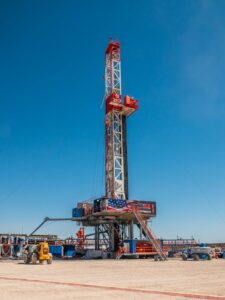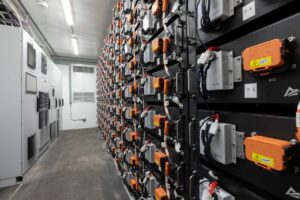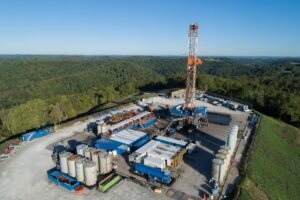Onshore contractors prioritize return to profitability as activity picks up, rig markets tighten


Patterson-UTI’s William Andrew “Andy” Hendricks: Already as lean as possible, drillers will look to term contracts and higher dayrates in the face of cost increases, demand for rig upgrades
By Stephen Whitfield, Associate Editor
William Andrew “Andy” Hendricks is President and CEO of Patterson-UTI.
What do you see as some of the biggest challenges that drilling contractors face in the current market?
When you step back and look at the macro of what drilling contractors have been facing over the last few years, it really is about getting back to a level of profitability that’s more in line with what our investors are expecting. A number of us are publicly traded companies, and our investors are looking for us to be more profitable than we are. Since 2014, we’ve gone through several cycles of downturns, which have led to oversupply in the market, softness in dayrates, and a real squeeze on our profitability.
Rig counts went up as we went through 2021, and I think rig count will continue to move up in 2022, even though we’re not going to be back to the same rig counts that we’ve seen in the past. My call is the US rig count will get somewhere between 650 to 700 toward the end of 2022. If I’m right, this is going to tighten the market, so dayrates are going to move up.
One thing that’s happening is that operators are requesting additional technology, maybe upgrades or changes on drilling rigs. As we get further into this year, these types of agreements will need to be covered by term contracts. They will need to make economic sense for the rig owners to be able to make these kinds of upgrades. If these upgrades are large – say, in the $8 million to $10 million range – that’s going to require operators to help us cover some of the costs upfront, not just cover the costs within the term of the contract. As drilling contractors, that’s what we need to see.

Another challenge is finding people. Unfortunately, in 2020, as we got into this COVID downturn, we had to release a large number of people to keep the business upright. As we started increasing activity in 2020 and throughout 2021, we reached a point fairly quickly where we saw that people who had worked in the energy space in the past were not coming back. We had to put systems in place for recruiting. We had to plan onboarding and training again. These are added efforts and costs for a drilling contractor.
We are finding people, so drilling contractors haven’t missed any work, but it’s taking more effort to find them than it used to, compared with late 2020 and early 2021. There’s a cost and a timeline associated with that.
You mentioned that dayrates will likely increase this year. Do you think the dayrate model is sustainable for drilling contractors, or does the industry need to look toward other business models?
I think the dayrate is still an important part of the model on how we charge for our assets. These are large assets that require a significant investment, and they have to be paid back over a period of time. Now, that doesn’t preclude us from also doing performance-based or non-traditional dayrate models on top of that. Roughly a third of our agreements with various customers already include some kind of performance component – that may be based on drilling faster, on reduced downtime or on commodity price movement. But, in general, I would say the dayrate models still make sense.
In recent years, we’ve seen drilling contractors make significant efforts to lower costs. Do you think this is a lever you can continue to pull? Are there any areas where drilling contractors could still be more cost efficient?
There are no cost efficiencies out there. The industry got as lean as it could possibly get during this COVID downturn. This has been to the benefit of the operators because they’re essentially paying lower dayrates than what’s really required for us to be reasonably profitable.
Going forward, I believe that operators will have to adjust for the higher dayrates that we will need in order to be reasonably profitable. As I mentioned earlier, if rig markets tighten this year, our dayrates are going to move up. You can’t take more costs out of the system than we already have and, in fact, you’ve got increasing costs because wages are going up, and wages make up about two-thirds of the daily cost to operate a drilling rig in the US market.
Other costs are also moving up, whether it’s tubulars, lubricants or expendables. Drilling contractors have been absorbing those costs, but that’s not a sustainable model and can’t continue.

You’re saying that there’s nowhere else drilling contractors can cut costs, and dayrates will increase moving forward. That sounds like a fragile equation. What happens if we see another downturn before we’ve fully recovered from this past one?
There are a couple points there. One, the equation’s been fragile since 2015. Dayrates have been soft, operators have gotten the benefit of the lower costs, and it just hasn’t been sustainable. So, it’s already been fragile. However, in 2022, I think drilling contractors will have a more positive output because I believe the rig count is going to move up.
Interestingly enough, the US rig count is not likely to get to a level where the US will become the swing producer, so OPEC+ will have more control over oil prices. That should likely add stability to the market. Once rig counts increase in 2022, they could be steady for a few years after that. In that market, drilling contractors should be able to increase dayrates and improve profitability.
Going back to the equation being fragile: The best way for a drilling contractor to manage that is to keep their debt low. That is fundamental, and we try to make sure that our balance sheet stays healthy at Patterson-UTI. It’s why we’ve had the opportunities to make some of the acquisitions that we have made over the years, such as Pioneer Energy Services last year.
What value does the acquisition of Pioneer bring to Patterson-UTI?
Pioneer has a great reputation with super-spec rigs in the US and a business in Colombia that had been working for 14 years. This was a good-quality business and good-quality assets, but it had some financial challenges. We had been following this business for years, and we had been looking for an opportunity when it would make sense for us to do something. 2021 was the year that it finally presented itself.
What would you say are the differentiating factors for a super-spec rig today?
Right now, it starts with the structure of the rig. As we talk to customers about what they’re looking for in a drilling rig, it starts with the rig structure first, and then it gets into automation or sustainable technology. The most-desired rig structure is one with a walking system and a drawworks on the floor that gives you the most clearance to get around wellheads and production systems on a multi-well pad. Then, the discussion moves onto the automation systems and the sustainable and low-emissions technologies that are being offered.
That’s where Patterson-UTI has found itself in a leadership position, with things like the EcoCell lithium battery hybrid system, or 100% natural gas engines, or even highline power where we can connect drilling rigs straight into the utility. We have an electrical engineering and controls division that gives us the ability to do that in house for our own drilling rigs.

What technological advancements can still be made that would draw greater efficiency gains out of the rig?
We’re at a point now where the efficiency we can achieve is at a critical level, and it’s more and more difficult to achieve improved efficiencies. However, by doing more in the areas of automation – for instance, by using our Cortex operating systems – we can be more consistent across our rig fleet and maximize the efficiency of those discrete operations that we’re automating. That will help shave hours and minutes off drilling times.
How do you see automation changing the role of the driller on the rig?
Over the years, the driller has taken on more and more responsibility, and the systems are producing more and more data. The goal of automation is to simplify some of this and take some of that load off the driller – whether it’s during simple things like putting the bit on bottom or steering the well in a directional mode – so that everything becomes less manual. We’ve been focusing on discrete automation projects that can help the driller focus on things like safety, well control, and planning ahead for the next operation on the well.
Do you think the industry is extracting as much value as it can out of the data it has available?
The industry is always learning how to produce more and more data, and then we find ourselves a little bit behind on how we use that data. But that’s just a natural evolution.
When we find more interesting and helpful data, we then have to develop systems to use that data, whether it’s data analytics, machine learning or, in the future, applying more artificial intelligence. But the key thing is, how do we help the driller do a better job?
Obviously, you need to spend money to invest in new systems for the rig. How do you balance that need to invest versus the need to keep debt low and maintain capital discipline in the current market?
This gets back to what I was discussing earlier. When operators make decisions on drilling rigs, the first thing they look at is the rig’s structure. They want a rig with a walking system and a rig with the drawworks up on the drill floor so that it maximizes clearance.
At Patterson-UTI, we’ve been building this style of rig for years. We don’t have to make large capital investments in the structure.
When you look at automation, data analytics and machine learning, these are actually low-capital investments. These are investments in people and engineering time, but not necessarily large capital. So, we’re in a good position at Patterson-UTI. The rig structure is in good shape, so we’re just layering on things like our Cortex operating system or our Cortex edge servers to improve the operation of the existing structure.
Oversupply of rigs has been an issue for drilling contractors in US onshore. Do you think that the market will get to a point where we may see more of a newbuild cycle, or is that something we’re not going to see anytime soon?
I don’t think we’re going to see a newbuild cycle in the next few years because there are enough of the types of rigs that operators want, although that market is tight. For instance, at Patterson-UTI, our most popular styles of rigs are our Apex XK and Apex PK, and we are essentially sold out of those rigs in the Permian. For an operator to get that type of rig, they will have to pay a higher dayrate. That’s a positive trend for drilling contractors.
At the onset of the COVID-19 pandemic, drilling contractors had to adopt new strategies to help manage the safety of their crews on the rig. Do you think the pandemic will have any long-lasting impacts on the way you manage your personnel?
I don’t pretend to be an epidemiologist, but this pandemic doesn’t seem to want to go away, and we may likely have to learn to live with it. I would say that, as we work through the pandemic, it’s been a learning curve.
During the wave of COVID that was experienced with the Delta variant in August and September last year, there were a lot of good lessons learned. We’ve got a lot of good processes in place based on those learnings to manage the pandemic. We really weren’t impacted operationally, but we did have to learn to manage it by keeping some extra people in the rotation and spending more dollars on testing people, and we have protocols in place for testing and isolation. That may be just part of what we’ll have to do for the foreseeable future.
Where do you see drilling contractors fitting into the energy transition and the low-carbon future?
I think drilling contractors will have a role to play because oil and gas will still have a role to play going forward. Drilling contractors drill wells. We will continue to drill wells, but we want to be able to drill wells better. Part of that means drilling more efficiently, and part of that means drilling with lower emissions, but then we’ll also participate in other types of projects.
For instance, we’ll look at more geothermal work, carbon sequestration and injection. All of that will fit into what drilling contractors do in the future. It will be about producing oil and gas in the most environmentally friendly way possible, but also participating in more environmentally friendly activities. DC




